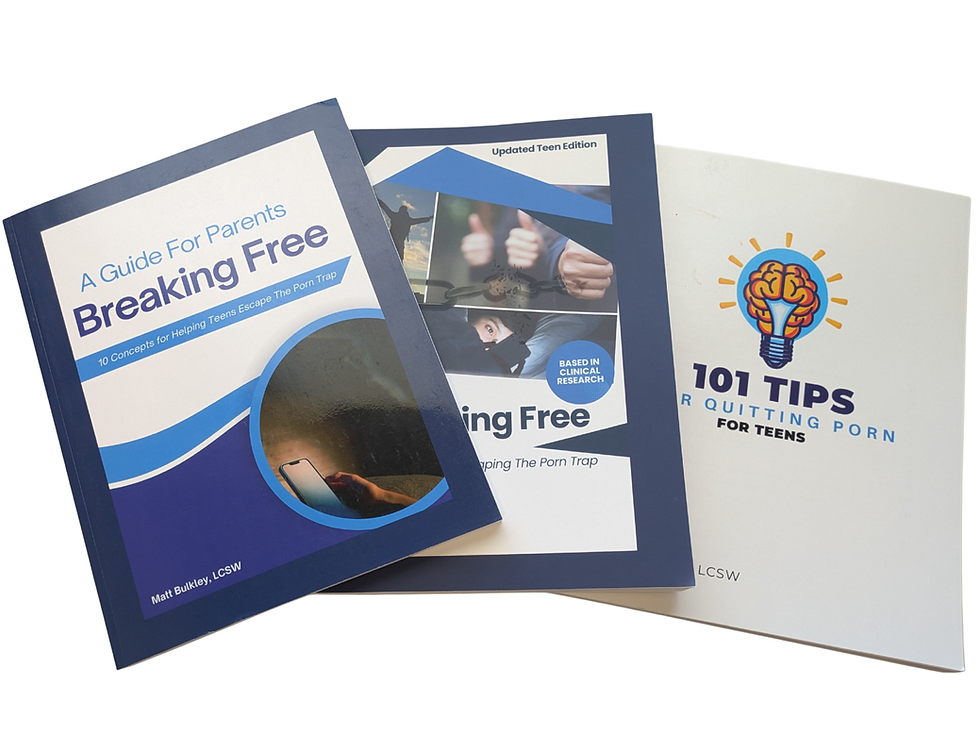The Role of Reducing Social Media Use: Helping Your Teen Break Free from Pornography Addiction
- Matt Bulkley

- Jun 16
- 4 min read
Updated: Jun 18
As a parent, you’re likely searching for practical ways to support your teen as they navigate the challenges of overcoming a pornography addiction. One effective strategy, backed by research and clinical expertise, is helping them reduce their time spent scrolling on social media. Platforms like TikTok, Instagram, and Snapchat can unintentionally fuel addictive behaviors by overstimulating the brain and exposing teens to triggering content. By understanding why cutting back on social media matters and how to guide your teen toward healthier habits, you can empower them to stay on track in their recovery. Here’s what you need to know.
The Science Behind Social Media and Addiction
Social media is designed to keep users engaged, delivering a constant stream of quick, rewarding content that lights up the brain’s reward system. This process releases dopamine, the same “feel-good” chemical involved in pornography addiction. According to a 2022 study published in Cyberpsychology, Behavior, and Social Networking, excessive social media use can amplify cravings for risky behaviors, including pornography, by keeping the brain in a state of seeking instant gratification. For teens, who are already navigating a developing brain, this overstimulation can make it harder to resist old habits.
Even seemingly harmless scrolling can expose teens to suggestive images, “thirst traps,” or links that act as gateways to explicit content. These triggers can pull your teen back toward pornography, derailing their progress. By reducing social media use, you help limit their exposure to these risks and give their brain a chance to break free from the cycle of chasing quick dopamine hits.
Insights from Addiction Experts
Clinicians who specialize in addiction recovery emphasize that social media can be a slippery slope for teens trying to overcome pornography addiction. Experts like Dr. Gary Wilson, known for his work on the brain’s response to addictive behaviors, explain that the endless scroll of social media keeps the brain in a heightened state of anticipation, similar to the patterns seen in pornography use. This “what’s next?” mindset makes it harder for teens to stay focused on their recovery goals.
A study from the Journal of Behavioral Addictions found that teens who reduced their social media use saw a 30% decrease in risky online behaviors, including accessing inappropriate content. By setting boundaries around social media, your teen can avoid the triggers that might otherwise lead them back to pornography.
Practical Steps to Reduce Social Media Use
The good news is that cutting back on social media doesn’t mean banning your teen’s phone or isolating them from their friends. It’s about creating healthier habits that support their recovery. Therapists often recommend simple, actionable strategies, such as:
Setting time limits: Encourage your teen to use a timer or app to cap their daily social media use at 20–30 minutes. Many smartphones have built-in features to track and limit screen time.
Curating their feed: Help your teen unfollow accounts or mute content that feels triggering or overly stimulating. Encourage them to follow positive, interest-based accounts, like those related to hobbies or learning.
Taking breaks: Suggest periodic “digital detox” days where your teen steps away from social media entirely to focus on offline activities like sports, reading, or spending time with family.
Replacing scrolling with meaningful activities: Encourage your teen to fill their time with engaging hobbies, such as learning a musical instrument, painting, or playing a sport, which can provide a healthier sense of accomplishment.
A 2023 review in Addictive Behaviors found that cutting social media use by half significantly reduced urges to view pornography. By dialing back the overstimulation, your teen’s brain has a chance to “reset,” making it easier to focus on building a healthier lifestyle.
Real-Life Impact
Counselors working with teens in recovery have seen firsthand how reducing social media use can make a difference. Teens who set boundaries around their scrolling habits are often better equipped to avoid triggers and stay committed to their goals. By clearing away the “static” of constant notifications and suggestive content, they can focus on activities that bring genuine fulfillment, like pursuing a passion or strengthening relationships.
How You Can Support Your Teen
As a parent, your guidance and encouragement are key to helping your teen reduce their social media use. Here are some ways to get started:
Have an open conversation: Talk to your teen about how social media might affect their recovery without judgment. Ask them which apps or content they find triggering and work together to set boundaries.
Model healthy habits: Show your teen how you manage your own screen time. For example, put your phone away during meals or family time to demonstrate the value of being present.
Provide alternatives: Help your teen find activities they enjoy to replace mindless scrolling. Whether it’s joining a sports team, taking an art class, or exploring a new hobby, these activities can fill the gap left by reduced social media use.
Celebrate small wins: Acknowledge your teen’s efforts to cut back on social media, even if it’s just using their phone a little less each day. Positive reinforcement can keep them motivated.
A Step Toward Recovery
Reducing social media use is a practical, science-backed way to support your teen’s journey to overcome pornography addiction. By limiting exposure to triggering content and calming the brain’s overstimulation, you’re helping your teen create space for healthier habits and a stronger sense of self. Recovery is a process, and every step forward counts.
If you’re looking for additional support, consider the Recovery Toolbox for Teens.










Comments